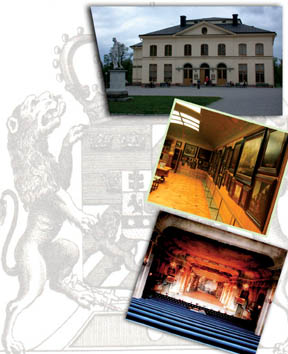
Little Blue Birdie's Diary:
More on Drottningholm Palace
Dear Diary,
Can you remember me writing about the Drottningholm Palace in my last
entry? Since it's a huge and historical place, there's a lot more to
write about.
Last time, I told you how, why and when the palace was built. Today,
I'll write about the other important buildings attached to the palace.
The Chinese Pavilion and Drottningholm Court Theatre are among them.
 This theatre, known as Drottningholm Slotsteater, is also an opera
house and a museum as well. It is internationally reputed as a summer
festival venue, and focuses on works of great musicians such as Haydn,
Handel, Gluck and Mozart and emphasises on authentic performances. The
theatre also has guest performances by the Royal Swedish Opera Company. This theatre, known as Drottningholm Slotsteater, is also an opera
house and a museum as well. It is internationally reputed as a summer
festival venue, and focuses on works of great musicians such as Haydn,
Handel, Gluck and Mozart and emphasises on authentic performances. The
theatre also has guest performances by the Royal Swedish Opera Company.
Construction of the theatre had begun in the 17th century. Its
interior decor belongs to the era between 1665 and 1703. It had first
been decorated in a heavy baroque style, but later had changed to French
patterns.
According to Robin, this 400-seat opera house was opened in 1766 by
Carl Fredrik Adelcrantz for Queen Lovisa Ulrika. The original theatre in
the palace was destroyed in a fire in 1762 and was rebuilt. I found the
interior decoration of the theatre absolutely marvellous. Mama Bird,
Papa Bird and I felt like we were visiting heaven.
According to Laughing Dove, a bird I met at the palace, who smiles
non-stop and had been there for many years, this had been decorated from
a mixture of Stucco (fine plaster used for coating wall surfaces or
moulding into architectural decorations), papier mache (a mixture of
paper and glue that is easily moulded but becomes hard when dry) and
paintings. She had heard this from a guide, who was explaining the place
to a visitor.
The stage machinery, which had been designed by an Italian, is still
intact and includes moving waves, trap doors, cloud cars, lighting
machinery and wind and thunder machinery. Since we were the Queen's
guests, we got the opportunity to experience all these things. It was
really wonderful.
"Do you know that this theatre was once used as a store?" asked
Robin. I was very confused and wondered how one can neglect such a
beautiful place. According to Robin, this had really happened. King
Gustav III had been very interested in art, music and drama. He had
helped artistes to enhance their abilities, but unfortunately, after his
death in 1792, no one had bothered about the theatre.
In 1920, the place was restored with the addition of electric lights,
designed to flicker like candles. It reopened to the public in August
1922, along with a part of the palace. The theatre is a bit unusual as
it has a significantly greater depth and width. "Almost all equipment we
use here are original", said the man who was in charge of the theatre.
This amazing place, along with the Drottningholm Palace, the China
Pavilion and the surrounding park, became the first Swedish landmark to
be included in UNESCO's list of World Heritage Sites.
After flying around the castle, and having had a great time, we came
back to Stockholm, to the great elm tree, where we nested. Although it
was beside a busy road, we didn't have a problem as the city was clean
and tidy.
It's a nice country as well, but I have to warn all the birds,
birdlings and kids who are planning to visit Sweden. Birds and birdlings,
when you are flying across the road, make sure you fly way above the
traffic; Swedish motorists too are learning to fly on their super
highways! |


